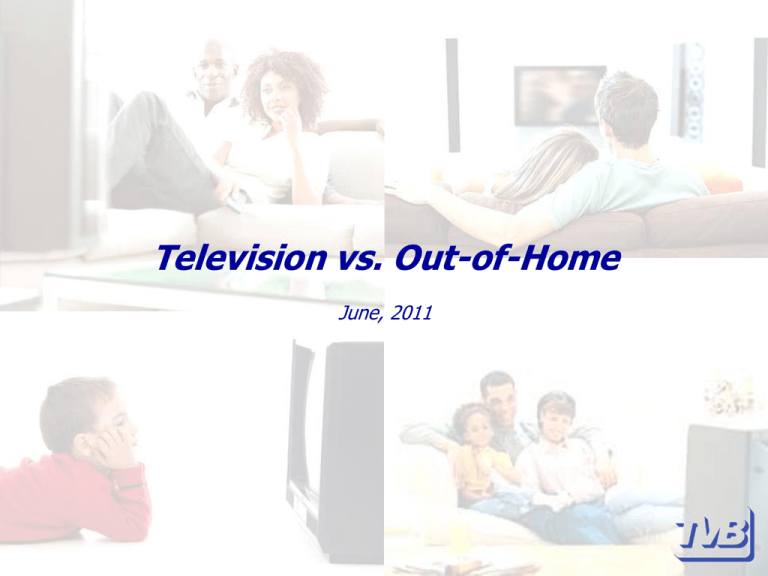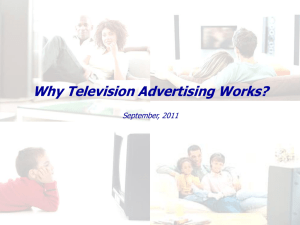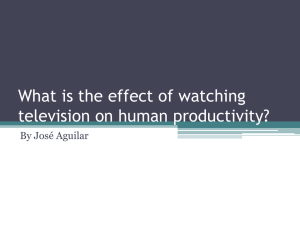Television vs. Out-of-Home
advertisement

Television vs. Out-of-Home June, 2011 Television vs. Out-of-Home • Television sets itself apart from other media with its ability to offer sight, sound, and motion to generate emotional responses from the viewer. • The qualities of television allow advertisers to create a long lasting and memorable brand image. • Television has unbeatable scale and reach that reaches audiences quickly and effectively. Television vs. Out-of-Home • The effectiveness of out-of-home advertising is derived from the frequency of the specific ads being seen. • Since most OOH ads stay in the exact same place for their campaign duration, only people who walk/drive by numerous times will notice the advertising. • OOH can have more marketing impact when viewers don’t have their filters up and see messages out of context. – For example, seeing Simon Cowell’s grinning face for The X Factor on a grocery shopping cart may make a potential viewer sit up and take notice. Source: http://www.marketingscoop.com/outdoor-advertising-advantage.htm Television vs. Out-of-Home • Outdoor advertising is a glance medium. At best, it only draws 2-3 seconds of a consumer’s time. • Messages must be brief to fit in that 2-3 second time frame. Ninety-five percent of the time, either the message or the audience is in motion. • TV reaches viewers when they are most receptive to advertising. Source: http://www.marketingscoop.com/outdoor-advertising-advantage.htm Television vs. Out-of-Home • Person-to-person communication is achieved through the combination of both the spoken word and unspoken elements such as body language and gestures. • Television has both visual and sound capabilities which allowing it to come closer than any other medium to offer ideal communication. • Television’s ability to touch people’s senses simultaneously creates a synergistic effect that cannot be duplicated by only stimulating an individual sense. Television vs. Out-of-Home • The nature of the way you have to buy outdoor advertising (usually monthly commitment) is not conducive to a very short campaign. • Out-of-home advertising is highly dependent on the location of the advertisement. • In order for an advertisement to be effective it must be placed in a high traffic area. This is usually very expensive and also has to compete with several other advertisements in the same area. Source: http://www.marketingscoop.com/outdoor-advertising-advantage.htm Television vs. Out-of-Home • A study to track the awareness of OOH ads was conducted by tracking a billboard for a Clark candy bar ad: – Awareness was measured just prior to the boards going up, one month into the campaign, two months into the campaign, and one month after the boards came down. – Awareness increased in the first month of the campaign and began to decline significantly during the second month of advertising while the boards were still up. – The decline slowed but still continued one month after the boards came down. Source: Journal of Advertising Research- December 1989/January 1990 Television vs. Out-of-Home Consumers Surveys • TVB participates in omnibus telephone surveys conducted by BBM Analytics to gauge consumers attitudes towards advertising in all major media and to gain insight into their behaviour with media • Surveys include: • • • • • Perception of Advertising Effectiveness Receptivity to Advertising Screen Preference Media Synergy PVR Impact Television vs. Out-of-Home Advertising Effectiveness Which ONE media source carries advertising that you believe to be the most Influential? A25-54 63.7 13.7 9.3 6.0 Television Source: BBM Analytics May 2010 Radio 3.2 Newspaper Magazines 1.2 Internet Out of home Television vs. Out-of-Home Advertising Effectiveness Which ONE media source carries advertising that you believe to be the most Persuasive? 64.1 A25-54 7.9 9.9 5.5 7.1 2.1 Television Source: BBM Analytics May 2010 Radio Newspaper Magazines Internet Out of home Television vs. Out-of-Home Advertising Effectiveness Which ONE media source carries advertising that you believe to be the most Powerful? 66.9 A25-54 6.5 Television Source: BBM Analytics May 2010 Radio 11.2 8.1 3.7 Newspaper Magazines 1.0 Internet Out of home Television vs. Out-of-Home Advertising Receptivity In which medium are you most likely to Notice advertising? A25-54 55.9 16.0 11.7 7.6 3.2 Television Source: BBM Analytics June 2010 Radio Newspaper Magazines 1.4 Internet Out of home Television vs. Out-of-Home Advertising Receptivity When are you most Receptive to advertising messages? A25-54 42.7 13.2 11.9 10.2 7.1 Watching Television Source: BBM Analytics June 2010 Listening to Reading a the Radio Newspaper Reading a Magazines 7.1 On the Internet Out of home Television vs. Out-of-Home Advertising Receptivity When do you pay the most Attention to advertising messages? A25-54 42.3 14.9 12.7 6.3 Watching Television Source: BBM Analytics June 2010 Listening to Reading a the Radio Newspaper Reading a Magazines 7.3 On the Internet 9.4 Out of home Television vs. Out-of-Home Advertising Receptivity Thinking about your Favourite advertisement, where did you see it? 68.2 A25-54 3.7 Television Source: BBM Analytics June 2010 Radio 4.7 Newspaper 7.1 3.7 2.7 Magazines Internet Out of home Television vs. Out-of-Home Advertising Receptivity Have you ever seen an ad that has made you Laugh or Cry? Where? 83.6 A25-54 88.2 10.9 Yes No 7.8 2.5 Television Source: BBM Analytics June 2010 Radio 0.3 Newspaper 1.3 0.8 Magazines Internet Out of home Television vs. Out-of-Home • Television commercials account for 10.3% of all word of mouth conversations in regards to brands. OOH ads are accounted for in a range of 1.7% (billboard) to 5.5% (in-store display) depending on the type of OOH medium being used. • Television is the leader in ad expenditure volume, as well as the leader in driving word of mouth volume. • TV has the ability to spark a conversation, and advertisers wanting to start lots of conversations quickly have to consider television. Source: ADMAP November 2010 Television vs. Out-of-Home Attitudes of adults towards product placement in TV shows • 24% agree to the statement “After I watch my favourite TV show, I can remember brand name products the characters were using during the show”. • 22% agree to the statement “To see a character interact with brand name products I use makes the show more real to me”. • 41% agree to the statement “When I watch TV, I often notice brand name products used as part of the set”. Source: TV Dimensions 2010 Television vs. Out-of-Home • Limited scope for message (e.g. no space for detailed text, phone number, location map) • Poor weather can affect the visibility of the advertisement, and limit the number of people even noticing the advertisement. • Outdoor advertising can be vandalized or fall into disrepair and reflect poorly on your brand or campaign. • Different municipalities have different by-laws/regulations in place to control outdoor signage and advertisements. Source: http://www.adglitz.com/2010/11/08/billboardoutdoor-advertising-disadvantages/ Television vs. Out-of-Home • TV ads stay up-to-date whereas OOH can be lagging with ads becoming out of date and obsolete quickly. TV can be put on the air in a relatively short period of time. • It's hard to reach a specific audience. It is difficult to target anything more than a small segment of a neighbourhood. • OOH advertising works well with a TV marketing campaign as an OOH ad can act as a reminder to what ads consumers saw on TV. Source: Marketing Tenth Edition, McGraw-Hill Ryerson 2004 Television vs. Out-of-Home • Although the cost of reaching an individual person is low, it does not match TV’s ability to compete on a national scale. • A national campaign using OOH ads would be highly expensive and would not be cost effective. • There is considerable public criticism in regards to the landscape defacing aspect that OOH advertising creates. • Billboards have to be maintained by the companies that erect them in order for the ads to appeal to consumers. This cost is usually passed on to the advertiser. Source: Marketing Tenth Edition, McGraw-Hill Ryerson 2004 Television vs. Out-of-Home • In Summary: – Television is far more effective than OOH in conveying an advertiser’s message as TV impacts the consumer’s several different senses simultaneously. – As outlined in various studies, people identify TV as the medium they find to be most effective, engaging, and persuasive. – Television has unbeatable reach and the ability to target mass audiences for ad campaigns. – TV brings ads to the consumer whereas for OOH the consumer must “find” the ad.






